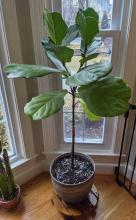The Four Best Ways to Baby Proof Your Houseplants
It’s such a joy when your little one shares your passion! Houseplants can be very interesting to toddlers, especially when they see us repeatedly caring for our indoor plants. It’s nice to let your little one help, but we still need to babyproof, or control, their access to your houseplants. This…Six More Ways to Baby Proof Your Plants
This is a follow up to my Four Best Ways to Baby Proof Houseplants blog that focused on blocking your baby from your houseplant’s soil. It’s not just the soil that’s tempting for your toddler, the leaves and stems are incredibly entertaining as well. Here are a number of reasons you may want to…How to Prune an Overgrown Money Tree
My Money Tree is one of my oldest plants. A well-cared-for Money Tree grows fairly quickly and may eventually outgrow your space. When this happens, a good pruning is in order. If you have an overgrown Money Tree, follow this post and I'll go over how to trim a tall Money Tree.Reasons for Money…Best North-Facing Window Plants
Placing your houseplant in front of a window doesn’t necessarily mean it will get enough light. This blog will help you pick out the best north-facing window plants. The hours of sunlight and the intensity of sunlight will change based on the direction of your window. This is due to Earth rotating…Best East-Facing Window Plants
It’s important to know the type, amount, and intensity of light coming through your window. This will help you select the best east-facing window plants. The number of hours of sunlight and the intensity of sunlight varies based on the direction of your window. This is due to Earth rotating on its…Best West-Facing Window Plants
Choosing the right spot for your plant, or the right plant for your spot, is all about the light. To select the best west facing window plants, you need to understand the source, amount, and intensity of light. The number of hours of sunlight and the intensity of sunlight vary based on the…Best South-Facing Window Plants
Choosing the right spot for your plant, or the right plant for your spot is all about the light. To select the best southwest-facing window plants, you need to understand the source, amount, and intensity of light. The number of hours of sunlight and the intensity of sunlight varies based on the…What Plant Should I Get Quiz? A Plant Recommendation Quiz.
Plants are everywhere now! They look awesome. You want one, but don’t know where to start. You want to know, “What plant should I get?” Or maybe you’re a seasoned collector but you're wracking your brain for your newest addition. No problem, take my Plant Quiz to get recommendations based on your…How to Use a Light Meter for Plants
In the last several blogs I have been writing about the light you can expect to receive from each window direction (north, south, east, and west). Many things affect the amount of light your window gets, not just window direction. I recently purchased a smart plant monitor to help me assess the…How to Get Rid of Spider Mites on Plants
Spider mites are plant pests that must be handled with speed. As a veteran spider mite fighter, I decided to write this quick guide to help anyone else battling spider mites on their indoor plants. I’m currently ridding a Limequat Tree of spider mites so it’s a timely endeavor. I will walk you…A How to Guide for Repotting Pothos
It can be difficult to know when to repot your plants, especially Pothos, because they are such vigorous growers. My Golden Pothos has needed a repotting for some time. In this blog I will walk you through repotting Pothos plants. You will learn how to recognize the signs your Pothos needs to be…Window Sill Planter: Ideas to Create More Space for Plants
I’ve been blogging about which plants are best suited for each window direction recently. See the north, south, east, and west facing windows blogs for more details. Now I want to give you some ideas of how to situate your plants to make the most of your windows. If you are looking for a window…How to Keep Cats Away from Plants
Cats are curious creatures. They may find the dangling leaves of your house plant especially intriguing. Some cats even like napping on the foliage or soil of your indoor plants. If they are being real jerks, they might dig in the soil or even chew on your plants! If you share your home with plants…Signs of an Overwatered Plant and How to Fix It
People love their plants and they want to feel like they’re actively caring for them. However, some plants get too much love in the form of water. I once read someone say they love their plants to death referring to watering. I think it's common problem. In reality, we want to water, or love, our…Jade Plant Pruning Step by Step (With Photos)
Jade Plants are exceptional houseplants. They are relatively easy to grow as long as you have a window that can provide adequate sunlight. I have a pretty big Jade Plant and I have been letting it fill in for several years. I bought it in 2016. It was a two-foot-long rooted cutting, probably from…Jade Plant Propagation: How to Multiply Your Jade Plant
Jades like many succulents are quite easy to propagate. They store a lot of moisture in their leaves, which helps them survive longer without roots compared to plants with thin leaves. In this blog post, I will answer all your jade plant propagation questions using examples of rooting a leaf, a…Follow These Steps When Repotting a Fiddle Leaf Fig
Fiddle Leaf Figs are having a moment in the spotlight right now. They have been a mainstay in the houseplant world, but have really grown in popularity the past few years. And why not? Show me a houseplant lover that doesn’t want a literal tree in their home. It can be hard to decide when to repot…Repotting Monstera Deliciosa in a Few Easy Steps
It’s repotting season at my house lately. Mainly because it’s winter, and it’s best to repot while plants are dormant. Also, my Monstera Delicsiosa has some roots popping out of the pot. Like my recent repotting posts for Pothos and Fiddle Leaf Figs, I’ll walk you through the basics so you can be…The Best Hanging Planter for Every Situation
A hanging planter is a must have accessory for plant collectors. They are a wonderful space-saving solution when you run out of room on your floor, window sills, and tables. Hanging planters are a great way to make sure you are making the most of your window real estate because we know plants crave…Seven Indoor Flowers That are Easy for Beginners
I’m a big fan of keeping houseplants that bloom. It adds a nice pop of color to your décor. If you love the thrill of getting a new leaf on your houseplant, you will equally enjoy it when you get your first flower bud! In this blog, I will give you the run-down on some of the most common flowering…






